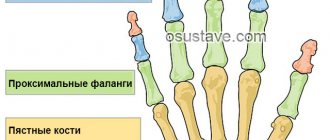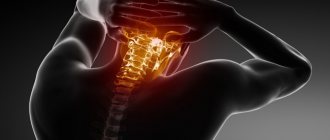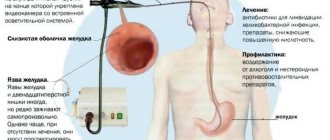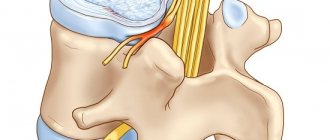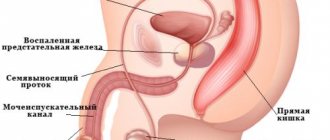Back pain between the shoulder blades is not a separate disease - it is only a symptom of a fairly wide range of pathologies: this includes diseases of the spine, the musculotendinous system, and the nerve roots “responsible” for this area.
Pain due to various diseases of the internal organs can also be felt in the interscapular area.
A quick and accurate diagnosis of the real cause of pain between the shoulder blades will help avoid the development of complications or severe chronic processes.
The main causes of pain
Diseases
There are a number of reasons why the thoracic spine may hurt:
- Kyphosis of the thoracic spine.
- Osteochondrosis.
- Kyphoscoliosis.
- Spondyloarthrosis.
- Disc protrusion.
- Intercostal neuralgia.
- Scoliosis.
- Osteoporosis.
- Shoulder-scapular periarthrosis.
- Injuries.
- Radiculitis of the cervical or thoracic spine.
- Myofascial pain.
- Intervertebral hernia of the cervical or thoracic spine.
- Flat feet.
Unfortunately, not only spinal diseases can cause pain in the spine in the area of the shoulder blades.
Diseases of internal organs can also lead to this symptom:
- Cardiac ischemia.
- Angina pectoris.
- Severe diseases of the lungs and pulmonary pleura.
- Liver diseases.
- Cholecystitis.
- Hepatitis.
- Ulcer.
- So-called “occupational diseases”.
- Arthrosis of the shoulder joint.
- Arthritis of the shoulder joint.
- Tumors.
- Meningitis.
- Tuberculosis.
- Poliomyelitis and many infectious diseases.
| Detailed information about osteoporosis treatment: |
Cancers
What are the symptoms of heart problems and how to distinguish one disease from another:
- With angina, painful sensations occur during physical activity, sometimes after excitement, alcohol, or heavy food. There is a feeling of heaviness, burning, compression behind the sternum on the left or in the heart area, destabilization of the rhythm. The attack passes in a few minutes. At rest there are no unpleasant sensations.
- Signs of myocardial infarction – pain spreading to the shoulders, arms, left side of the back, heaviness, shortness of breath, fatigue, weakness. Unlike angina, pain occurs at rest. Vomiting or nausea, or a feeling of panic may be present.
- Myocarditis has similar symptoms. With it, the patient also experiences headaches, constant physical and emotional malaise, and swelling develops.
But pain in the sternum is not always a signal that the “heart is acting up.” Pain radiating to the shoulder blades indicates a hypertensive crisis, injuries, and diseases of the respiratory system.
It is diagnosed by pain in the area of the shoulder blades and diseases of the stomach and other organs. Very often this is a stomach ulcer.
Its symptoms:
- back pain is localized in the area of the left shoulder blade;
- it appears after certain foods;
- after vomiting (which often has no objective reasons), the unpleasant sensations weaken;
- the appearance of pain is associated with seasonality;
- increasing pain sensations.
Pain under the left shoulder blade, radiating to the sternum and solar plexus area, combined with vomiting, depending on food intake, are the main signs of an ulcer.
Painful sensations in the shoulder blades, but already radiating to the right side of the back and chest, is a symptom of colic - hepatic or biliary. This pain is extremely severe, especially in the morning and at night. Also accompanied by vomiting and caused by food.
Violation of the diet, a large amount of fatty foods creates nervous excitement and pain.
Subphrenic abscess is an extremely unpleasant phenomenon caused by other organ disorders. Due to appendicitis or peritonitis, pus accumulates under the diaphragm. Acute pain in the area of the shoulder blades radiates to the arm, intensifies when inhaling, and the patient has a fever.
Diseases of the kidneys, duodenum, cholecystitis are manifested by nagging, aching pain under the right or left shoulder blade.
The final diagnosis must be made by a doctor, but with the help of certain signs you can pre-diagnose a particular problem that causes pain between the shoulder blades. You need to confirm your guesses using x-rays, computed tomography or MRI.
- Scoliosis. In this case, there is pain between the shoulder blades and in the chest. Suffering intensifies in two situations: with prolonged stress or with a long stay in one position. When the disease has progressed quite strongly, you can even visually assess that the body is curved and the arms are asymmetrical (one arm is lower than the other). Usually, pain between the shoulder blades and in the chest periodically concentrates in one place, because the curvature is in one direction.
- Osteochondrosis. It can be suspected if there is pain between the shoulder blades and difficulty breathing or coughing. This is especially noticeable during colds. The patient may have the impression that he has a stake instead of a spine. Your back may crack when you move.
- Spondyloarthrosis is very similar to osteochondrosis. There is no difference in symptoms, therefore, to distinguish between these diseases, an x-ray is needed. Determining exactly what disease a person is facing is necessary because there are differences in treatment.
- Disc protrusion or intervertebral hernia. Pain and burning between the shoulder blades occurs in a specific place, and usually persists there. If it is an area in the sternum, a person may even think it is related to heart or lung problems.
- If the vertebra between the shoulder blades hurts when pressing, most likely we are talking about intercostal neuralgia. This disease is especially unpleasant because the pain sometimes does not go away at any time of the day.
- Back pain between the shoulder blades from angina comes in attacks. It also radiates to the sternum and left arm. The attack lasts up to 5 minutes. Unpleasant sensations recur periodically. Angina pectoris is characterized by burning pain.
- With a heart attack, the pain lasts more than 5 minutes. There is not only pain between the shoulder blades and difficulty breathing (shortness of breath), but also unpleasant sensations in the lower jaw. The pressure is further reduced.
- Oddly enough, sometimes the spine aches between the shoulder blades due to an ulcer. But it has pronounced signs that make it possible to distinguish it from other diseases. For example, heartburn, vomiting or nausea. In this case, immediately after vomiting occurs, the pain decreases.
- With cholesticitis, vomiting and nausea can also occur, but in addition to this, the temperature rises. In this case, the vertebrae between the shoulder blades hurt, but not as much as the stomach itself, in which there is a cutting and stabbing sensation.
- A nagging pain between the shoulder blades can also occur with pancreatitis. With it, the pain on the right side is described as “boring”, sharp and unbearable.
- Pain in the spine between the shoulder blades, which radiates into the chest, may be caused by pneumonia. It is difficult to breathe, and the temperature is high or very high.
- Symptoms of pleurisy are similar to pneumonia, with the difference that with it, painful sensations between the shoulder blades and in the chest occur only when inhaling.
Scoliosis Disc protrusion Osteochondrosis Kyphosis
Let’s summarize what disorders can cause pain between the shoulder blades and in various organs:
- Diseases of the vertebrae: osteochondrosis, scoliosis, vertebral displacement, kyphosis, kyphoscoliosis, protrusion of intervertebral discs, intervertebral hernia, spondyloarthrosis, periarthritis;
- Respiratory diseases: pneumonia, pleurisy, pneumonia;
- Heart disease: ischemia, angina pectoris;
- Diseases of other organs: kidneys, stomach, pancreas, gall bladder, nerves (intercostal neuralgia);
- Infections: tuberculosis, polio.
By the way, with neuralgia it is really difficult to diagnose the cause. In addition to computer diagnostics, ultrasound, x-rays, and x-ray contrast studies may be required.
In this case, pain between the shoulder blades is not a cause, but a consequence. In fact, it originates between the ribs and simply radiates into the shoulder blades. At the same time, breathing is sometimes difficult. Sweating may increase, the skin may change color (turn red or pale), and with any sudden movements the pain intensifies. It either comes in bursts or does not stop at all.
Such symptoms can drive a person to panic. And although neuralgia is not life-threatening, unpleasant pain can significantly reduce its quality.
Pleurisy is inflammation of the lining of the lung. With this disease, chest pain radiates to the shoulder blade. It appears from the side of inflammation in the chest. Therefore, it can occur on the right and between the shoulder blades. Algia necessarily intensifies with any effort, for example, when coughing or moving. The temperature rises and the general condition is disturbed, shortness of breath and a dry cough appear. Pain between the shoulder blades indicates damage to the posterior pleura.
Coronary heart disease has 2 forms – heart attack and angina. Angina is characterized by attacks of pain with pressure on the sternum; they last no more than 5 minutes, and they can be relieved with nitrates. Pain in the left chest can radiate under the left shoulder blade, into the left arm and into the area between the shoulder blades.
Myocardial infarction is also characterized by unpleasant sensations in the chest, between the shoulder blades, but they do not go away after validol and nitroglycerin and last a long time. Other differences from angina:
- severe pain between the breasts is possible, and the lower jaw may also hurt;
- fear of death appears;
- pressure is reduced;
- pale skin, cold sweat.
You need to call an ambulance immediately.
With gastrointestinal diseases, chest pain radiating to the shoulder blade is a common occurrence.
With a stomach ulcer, thoracalgia can be strong or aching, radiating to the left scapula and interscapular area. The pain may increase when eating certain foods. Other manifestations are also present: heartburn, belching of air, increased salivation, regurgitation.
Ulcerative pain is special in that it occurs after eating, during fasting or at night. Nausea and sour vomiting may occur, followed by relief.
In oncology, pain appears already in the last stages of the disease. They vary in intensity, radiating to the back and between the shoulder blades. Localized on the affected side, radiating to the neck and shoulder. The intensity and duration vary. They can be transient or permanent.
Usually such patients are already very weakened and cachectic. Most often, chest pain is characteristic of cancer of the esophagus, lungs, breast cancer, pancreas and liver.
How to get rid of back discomfort at home
It takes very little effort to remove the pain.
Stretch and find a comfortable position
If you work in an uncomfortable position, then you just need to change it and warm up a little.
To do this, it is best to make several circular movements with your shoulders, turn several times, and also move and move your shoulder blades apart.
You can also do the following exercise: while sitting or standing, hug yourself tightly so that your shoulder blades open, then take a deep breath so that your shoulder blades open even more, hold your breath for a few seconds and exhale. During these exercises, muscle spasm is relieved, after which the pain quietly goes away.
Massage
A massage will help relieve pain very well.
And you don’t have to go to a massage therapist; you can even rub those muscles that are in the accessible area yourself, or ask one of your colleagues or loved ones about it, depending on where you are. If the pain occurs due to dystrophic changes in tendons and ligaments, then you need to keep in mind that calcium salts are sometimes deposited in the tissues when proper nutrition is disrupted.
Such damage can occur due to mechanical trauma and is less treatable.
How else can you help yourself with these pains?
To do this, you should buy a tennis ball.
You need to put the ball on the floor and lie on it with your back, then start “rolling” on it along the vertebra on both sides. This procedure must be done for about 3, or up to 5 minutes. But delaying it longer is dangerous, as it can lead to increased pain. To improve the processes, it is necessary to carry out the procedure for 3-4 weeks.
All this can be supplemented with a light massage-rubbing along the spine and the exercises indicated above.
Back exercises
- Tilt the head forward while simultaneously pressing on the forehead with the fingers, which must be kept intertwined. Then hand pressure on the back of the head, the left temple, then the right. Hands and head should counteract each other. Each movement is 10 seconds.
- Lying on your back, bend your knees . Then we press our left hand onto the knee of the right leg, which counteracts the hand. We keep doing this until we are completely tired. Then we change hands. Exercise will strengthen your back muscles.
- From a lying position, bend one leg at the knee, wrap your arms around it and try to press it to your chest . We hold until fatigue. Then do the same with the other leg. Then we bend both legs, press them to our chest and try to swing on our spine. This will help stretch the muscles. We only do it on a hard surface.
Important information about physical therapy is in a special section:. In particular, we recommend reading the article: “Exercises to strengthen the back with scoliosis.”
Possible nature of pain ↑
Let us give various examples of diseases based on the nature of pain.
It should be taken into account that there is no direct and 100% guarantee of an accurate diagnosis based only on this criterion, since the pain threshold and sensations for the same disease differ from person to person.
Sharp
Pain of this nature usually appears in response to pinching, inflammation or irritation of one or more spinal nerve roots: this is what used to be called “sciatica”.
It is a consequence of other pathological conditions, for example, osteochondrosis or scoliosis. Because of this, swelling and inflammation occur in the area of the pinched root, which provokes reflex tension in certain back muscles.
As a result of this muscle spasm, the root is pinched even more.
Biliary colic also manifests itself as sharp pains, only they occur not only between the shoulder blades, but also in the area of the right hypochondrium.
In this case, there is a connection between eating fatty, spicy, fried or spicy foods: pain appears 3-5 hours after such a meal.
In addition to pain, general health also suffers, nausea and vomiting appear.
Strong
This word most often describes pain in the following conditions:
- Protrusion of the intervertebral disc;
- Intercostal neuralgia, during which a person is even afraid to take a breath;
- Pancreatitis. It is accompanied by other symptoms: bloating, diarrhea, and general impairment;
- Myocardial infarction. In this case, your well-being also suffers significantly. Loss of consciousness, arrhythmias, and decreased blood pressure often occur.
Fig.: protrusion and herniation of the intervertebral disc
Burning
In this case, two conditions are differentiated - ischemic cardiac pathology (its subtype is angina) and osteochondrosis.
With ischemic heart disease pain:
- it will be burning, squeezing;
- does not last long (only with a heart attack);
- goes away within a few minutes after taking nitroglycerin;
- does not depend on movement;
- subsides at rest.
When a nerve root is pinched, the pain is:
- associated with movement;
- goes away after taking painkillers or when taking a certain position;
- does not respond to nitroglycerin.
Acute
It is observed in the following diseases:
- attack of cholecystitis: appears in response to eating fatty, spicy, fried foods, it also hurts on the right under the ribs
- a stomach ulcer that has opened (penetrated) into the pancreas: in this case, there will be pain not only between the shoulder blades, but also in the abdomen
- exacerbation of osteochondrosis of the thoracic region: such pain arose in response to some kind of movement or lifting of weight.
Aching
This type of pain almost always indicates diseases of the spine and bones:
- kyphoscoliosis;
- intervertebral disc herniation;
- scapular-costal syndrome;
- fibromyalgia;
- spondyloarthrosis.
In some cases, peptic ulcer and ischemic heart disease may manifest themselves this way.
Pulling
This is pain characteristic of musculoskeletal structures:
- myofascial syndrome;
- osteochondrosis of the thoracic or cervical spine;
- scapular-costal syndrome.
Dumb
Almost 90% of the causes of pain described by the characteristic “dull” are pathologies of muscles, tendons and ligaments.
The remaining causes are almost equally divided between osteochondrosis and pathology of internal organs (pneumonia, angina pectoris, cholecystitis, cholelithiasis).
If the cause of the pain is the spine, then it can be described as follows:
- the pain does not radiate to other parts of the body;
- increases with physical activity that involves sore muscles;
- the area hurts when palpated.
Stabbing
This is a symptom of the following conditions:
- Pleurisy. Then, in addition to pain, the person will notice a cough and weakness.
- Beginning perforation of the ulcer. In this case, before this there was abdominal pain, heartburn, nausea, and bloating.
- Vegetative-vascular dystonia.
- Biliary colic.
- Pyelonephritis.
Drug treatment
If an inflammatory process occurs in the muscles, then it is necessary to undergo a course of treatment with anti-inflammatory drugs, such as Dikloberl , Diclofenac , Voltaren , Ortofen .
This course is carried out over 3-4 days.
The inflamed area also needs external medications:
- hydrocortisone ointment;
- Fastum-gel;
- indomethacin ointment;
- Diclaggel.
When the inflammation subsides, you can use external drugs that irritate the nerve endings : “Asterisk”, Menovazin and others. In the third week, it is worth switching to drugs that affect blood vessels, such as Nicroflex .
If after the first week of treatment there are no changes in a positive direction, immediately contact the hospital.
Pericarditis
This is an infectious lesion of the serous membrane of the heart muscle with the development of inflammation in it. The pain is felt deep in the chest in the heart. It increases when the patient takes a horizontal position. The sensations are aching, strong, radiating to the shoulder blade, neck, arm. Accompanied by shortness of breath, weakness, decreased blood pressure and the appearance of edema, increased temperature for a long time (within 37.1–38 degrees). A blood test shows inflammation. The clinical picture is similar to a heart attack, so X-rays are required for differentiation.
Professional help
When treated in a hospital, pain is relieved using a comprehensive treatment method. This involves the use of medications, physiotherapy and exercise therapy. The doctor calculates the required complex for each patient individually.
Medications
Anti-inflammatory drugs that do not contain steroids are used as medications: ketonal, nimika, movalis, etc.
Physiotherapy
Physiotherapeutic procedures include:
- Ultrasound therapy.
- Electrophoresis of nimide and lidase.
- Traction.
- Massages.
- Electrotherapy.
- Laser exposure.
- Acupuncture.
- Soft manual therapy methods.
- Spa treatment.
The course of treatment for acute pain in the spine between the shoulder blades is 7-10 sessions. Chronic pain goes away after 10-12 sessions.
Which doctor should I contact?
For back pain, you usually contact the following specialists:
- traumatologist;
- pulmonologist;
- rheumatologist;
- chiropractor;
- neurologist;
- masseur;
- cardiologist.
Pneumonia
The inflammation may involve one or both lungs. Chest pain radiates between the shoulder blades and occurs in the chest when the posterior parts of the lungs are affected. Unpleasant sensations often occur on the affected side, where there is inflammation.
Signs of pneumonia:
- coughing;
- At first the cough is dry, then becomes wet;
- heat;
- shortness of breath, chest pain.
Chest pain radiating under the scapula on the left can occur with left-sided damage to the lung tissue.
Prevention
- After the course of treatment, it is necessary to exclude various physical activities.
- Do gymnastics every day, including exercises to strengthen the back muscles.
- Try to avoid overworking your thoracic muscles and lifting large, heavy things.
- Maintain your physical fitness and be active.
- Learn the correct movements.
- Watch your posture.
If you are experiencing problems with posture, we advise you to pay attention to the articles from the section: “Means for the prevention and treatment of postural disorders.”
Here you will find tips on choosing the most suitable back corset: semi-rigid lumbosacral or magnetic.
Diagnostics
The diagnostic program will depend on the current clinical picture and the history collected during the initial examination. To make an accurate diagnosis, the doctor may prescribe the following laboratory and instrumental examination methods:
- general clinical and biochemical blood test;
- general urine analysis;
- chest x-ray in two projections;
- CT;
- MRI;
- ECG;
- Ultrasound of the abdominal cavity and heart.
Performing an ultrasound of the heart
Based on the examination results, the doctor can make an accurate diagnosis and select the most effective treatment tactics.
Answers to frequently asked questions
Why does pain occur between the shoulder blades when turning or tilting the head?
Pain can occur due to degenerative-dystrophic pathologies of the spine - vertebrogenic cervicalgia and thoracalgia, cervicothoracalgia.
Why does the spine between the shoulder blades hurt when you inhale?
This symptom can be observed with intercostal neuralgia or overload of the pectoral muscles.
Why does pain appear in the spine between the shoulder blades during pregnancy?
One of the main reasons is an enlarged uterus, which is why a woman, when changing her position, needs to use additional muscles that we do not actively use during such actions.
Why does my spine hurt after sleep?
This may be due to osteochondrosis, curvature of the spine, or even just an uncomfortable sleeping position.
Causes of pain development
The causes of pain between the shoulder blades are very diverse, but most often associated with diseases of the musculoskeletal system. The most common pathologies include:
- intervertebral hernia;
- scoliosis;
- prolonged exposure to low temperatures and muscle strain;
- muscle myositis;
- osteochondrosis;
- spondyloarthrosis;
- diseases of internal organs.
Diseases of the musculoskeletal system are most often the cause of pain between the shoulder blades
Below is a brief description of each disease, as well as a description of the pathological process that occurs in the area of the shoulder blades.
Intervertebral hernia
Intervertebral hernia is very rarely located in the spine between the shoulder blades, since there is very little load on this section. But there are exceptions to all situations, and there are people whose hernia is localized in this particular place. In order to confirm or refute the diagnosis, it is worth consulting a neurologist, as well as undergoing an examination using a computer or magnetic resonance imaging scanner.
If the hernia affects the thoracic region, then degenerative changes are observed between the vertebrae and part of the disc protrudes outward. The disc may crack, and the core, which acts as a shock absorber, crashes into it due to improper weight redistribution. Against the background of all of the above, the nerve endings become pinched, and the back between the shoulder blades begins to burn.
Treatment of this disease is carried out with the help of non-steroidal anti-inflammatory drugs. Physical therapy and physiotherapeutic procedures are added to the tablets. For large hernias, only surgical intervention is indicated.
A characteristic diagnostic sign of an interscapular hernia is pain behind the chest, which can be confused with cardiac pain. If the process starts and treatment is started too late, curvature of the spine and partial paralysis of the lower extremities may develop. Over time, the pain becomes chronic.
Scoliosis
Scoliosis is probably one of the most common diseases of the musculoskeletal system. According to statistics, almost 60% of the world's population suffers from this pathology. With scoliosis, the sternum is affected more often. The reasons for the development of an unpleasant condition include:
- long stay of the spine in a sitting position;
- congenital anomalies;
- spinal injuries.
Scoliosis is characterized by severe pain in the middle of the shoulder blades, this is a signal that a gradual curvature of the spine is occurring. In the early stages of the disease, changes may not be noticed, but with further progress, a twisted spine becomes noticeable.
Scoliosis is diagnosed in almost 60% of the country's population
Due to constant pain and the unnatural position of the vertebrae, the back gets tired very quickly, and you can also notice a change in the level of the shoulders. Painful urges can radiate to the chest area and persist for a long time. If a person with scoliosis begins to exercise, he will feel sharp and piercing pain.
The treatment takes a very long time. Patients should wear a special corset, which helps to stretch the vertebrae, and also add physical therapy with moderate loads and massage procedures. For severe pain, analgesics and anti-inflammatory drugs are prescribed.
Causes of pain under the left shoulder blade
Pain under the left shoulder blade can be due to the following reasons:
- incorrect position while sleeping. In this case, a person wakes up with pain under the left shoulder blade and in the left shoulder. This pain usually goes away quite quickly;
- stomach ulcer. Peptic ulcer is a fairly common cause of pain under the left shoulder blade. In this case, the pain, as a rule, is aching in nature, gradually increasing, accompanied by gagging, heartburn and belching. After vomiting there is usually relief. As a rule, with a peptic ulcer, the onset of pain is associated with food intake;
- stress, panic and other psychological reasons. Psychogenic pain is described as congestion, compression, heaviness; may be accompanied by fever or a tingling sensation. Sometimes dizziness or a feeling of a lump in the throat is added. In this case, the pain is localized in the chest, and radiates under the left shoulder blade (people say “gives away”). The pain can spread wider, involving the shoulder blade itself, the neck, turning into a headache;
- heart diseases such as myocarditis, angina pectoris, myocardial infarction. A heart problem is very likely if there is pain both under the left shoulder blade and behind the sternum;
- osteochondrosis. With osteochondrosis, pain often occurs in the morning, that is, a person wakes up with pain. Patients in this case often say that the pain under the shoulder blade radiates to the arm or head;
- intercostal neuralgia;
- inflammatory lung diseases, in particular pneumonia.
This list contains the most common causes; the full list of causes of pain under the left shoulder blade is much longer.
How to proceed{q}
The appearance of pain between the shoulder blades is not normal, so you should consult a doctor as soon as possible and find out the cause. Tolerating or ignoring pain is dangerous. After visiting a doctor, you may be prescribed:
- temporary pain relief with nimesil, ibuprofen, Mavalis and other medications;
- diagnostics. At this stage, the exact cause of the disease is determined and a subsequent treatment program is formed;
- physiotherapy. In cases where pain is neurogenic or vertebogenic in nature, physiotherapy is prescribed. Please note that this treatment has contraindications - the presence of pus, tumor or infection;
- compresses, home procedures if the vertebrogenic nature of the pain is proven;
- massage and manual therapy - may be useful for problems with nerve endings or the spine;
- injection therapy.
Exercises while standing
Next, move on to training.
Neck: Move your head up and down (10 times). Then tilt left and right (10 times), then turn right and left (10 times), then perform circular rotations with your head clockwise and counterclockwise (10 times). Be very careful. The neck is easier to pull than other parts of the body.
Chest: Bends are ideal for training these muscles. Start with the basics - stretch up, then lower your arms. Then raise your arms up, put your palms together and bend left and right.
https://www.youtube.com/watch{q}v=9OuT2XtquPI
To begin, choose a flat, hard surface. The floor is best. Lie on your stomach with your arms extended along your body.
You need to raise your head while keeping your chin straight. Stay in this position for 30 seconds, then return to the original position.
Lie on your back, lift your head off the floor, first straight, then slightly tilting to the right and left.
Folk remedies for pain between the shoulder blades, chest and neck
To avoid side effects caused by chemical painkillers, you can turn to traditional medicine. But this point must be agreed with the attending physician. If the pain between the shoulder blades, neck and chest is too severe, then injections will most likely be required.
One of the simplest remedies is basil decoction. You can buy it in almost any store in the spice section. It also grows in some people’s gardens. 1.5-2 tablespoons of dry or fresh leaves and pour 2-2.5 glasses of water. Cook everything over low heat until the water has evaporated by half. Then strain, divide into 2 parts and drink 2 times a day. If the pain between the shoulder blades is severe, you can double the amount of decoction.
Chamomile is also good because it has a relaxing and analgesic effect. Making tea is very quick and easy - 2 tbsp. l. Pour dried chamomile flowers into two glasses of hot water, let the composition brew in a glass container under a closed lid for about 10 minutes, drink.
A product such as ginger root will also improve the condition, and you can take it both raw and dry. It can be added to food or made into ginger tea. For pain between the shoulder blades, in the neck or sternum, you can grate ginger on a fine grater or brew it with a small amount of water (to a paste) and apply to the sore spot for 2 hours. Lightly massage the sore area with ginger, cover it with gauze, then bandage it with a towel or woolen scarf to keep warm.
Garlic also has a warming and analgesic effect. If there are no stomach problems, 1-2 cloves should be eaten on an empty stomach for 2-3 weeks. The pain in the neck and between the shoulder blades, if not completely gone, will decrease significantly. And the sore spot can be rubbed with garlic oil; it is sold in many pharmacies.
Prevention of back pain between the shoulder blades
Even the most serious pathologies, such as spinal curvatures, protrusions and hernias, osteochondrosis and arthrosis, can be effectively contained so that the diseases do not progress. To do this, you need to adhere to a special diet indicated for certain disorders, as well as increase mobility.
There are many proven methods for restoring spinal mobility - the Bubnovsky, Dikul method. The simplest way in appearance is yoga, which is based on simple movements and breathing techniques. In this way, you can not only restore the mobility of your joints and spine, but also relieve psychological stress and improve your mood.
Sanatorium treatment can be replaced by regular physiotherapeutic procedures in a local hospital - these are mud wraps, acupuncture, magnetic therapy.
You can warm the sore spot between the shoulder blades only after a diagnosis has been made. For some problems, warming up can be dangerous.
Additional intake of vitamins and minerals in the form of concentrated dietary supplements or complex pharmaceutical preparations helps in providing tissues with nutrients, enhances metabolism, and improves immunity.
Hernia in the esophageal opening of the diaphragm
May occur with severe vomiting. Characterized by pain in the middle of the chest, with a return to the back - under and into the scapula, interscapular space. The pain is acute and intensifies with any effort or inhalation. Seeing a doctor should be urgent.
With this pathology, internal organs (their upper part) can penetrate from the abdominal cavity into the thoracic cavity. In this case, the pain in the chest on the left radiates to the scapula. It is always accompanied by heartburn and worsens when lying down. When eating food, the condition worsens.


